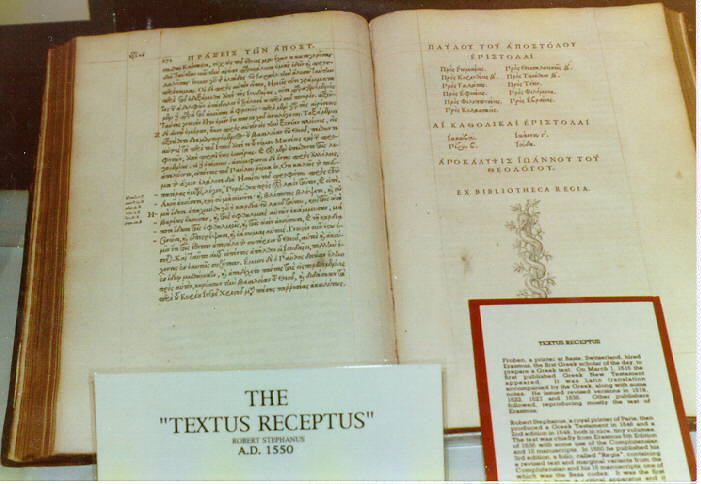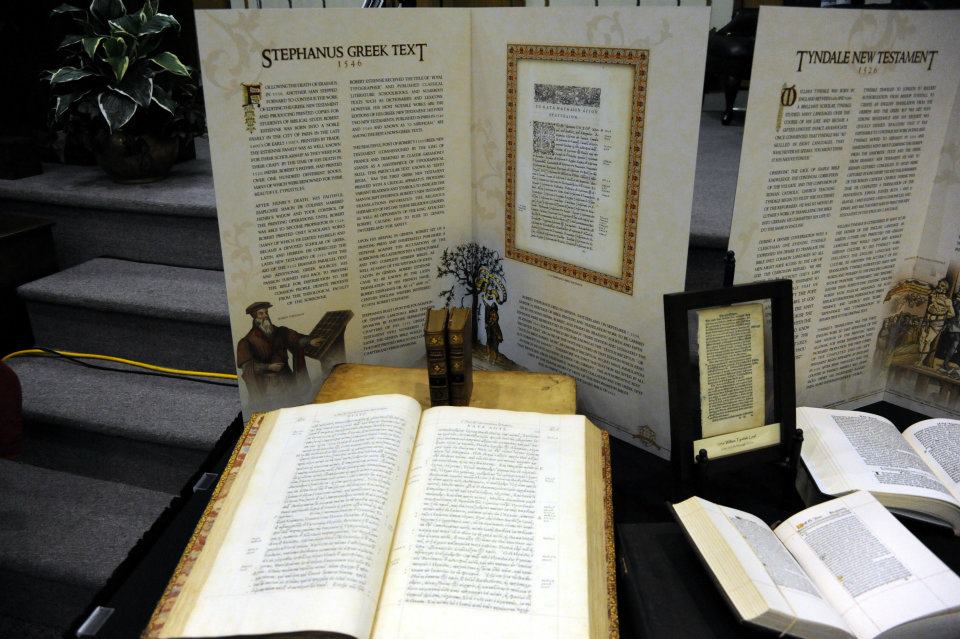|
**List: Greek Ministry
Holy Bible ( γραφαῖς ἁγίαις,
Αγιας Γραφης
)
*Book: DEFENDING THE KING JAMES BIBLE (1992, 1999) D. A. Waite
A four-fold superiority:
[] Texts {pp. 38-61: N.T. Greek Text.}
[] Translators
[] Technique
[] Theology
Booklet/*File: "FOUR REASONS for DEFENDING THE
KING JAMES BIBLE" (7-21-1993) D. A. Waite [brief summary]
[
DKJB ]
["The Greek Text that Underlies the KJB. ...the
Greek New Testament text. ...the Textus Receptus that underlies the
KJB. The Trinitarian Bible Society has published this text and made it
available to anyone. The TBS took their text from that of Dr. Frederick
Scrivener who was commissioned in about 1885, by the Cambridge University
Press, to come up with the exact Greek text that underlies the KJB.
Scrivener set down all of the Greek words used by the KJB, but he did
something else as well. He put in BOLD FACE TYPE all
of the alterations made by editors Westcott and Hort in their 1881 English
Revised Version. He inserted the exact alterations in the
footnotes. These consisted of either additions of Greek words,
subtractions of Greek words, or changes of Greek words in some other way.
This Greek text edition has been reprinted by the BIBLE FOR TODAY, and
is available through them or the DEAN BURGON SOCIETY. It is a very
useful tool. Scrivener's Greek text is also available on the LOGOS
Computer Program (available from THE BIBLE FOR TODAY) which enables the
student to study more carefully. Dr. Jack Moorman counted 140,521 Greek
words in the Textus Receptus. Scrivener's Greek edition has 647 pages
which would average 217 Greek words per page. That's what the Textus
Receptus has."]
Greek: Ancient...
"When we speak of Ancient
Greek in a Biblical sense, we do
not
refer to the ‘Classical’ Greek of the thinkers, poets, and play-
wrights of the Attic, or Athenian, civilization (before c. 322
B.C.). The Greek of the New Testament is Hellenistic Greek,
usually said to have developed in the camps and armies of Alex-
ander the Great and to have been carried by his armies through-
out the world he conquered. However, Hellenistic Greek is a
vernacular mixture of the Attic and Ionic usages and began its
development as early as the 5th century B.C. The spoken idiom
of the Hellenistic Period (300 B.C.-500 A.D.) was Koine, or
‘Common’, Greek, a form of the Greek language which came
into use in the Seleucid and Ptolemaic empires, and later spread
throughout nearly the whole Mediterranean world.
Hellenistic literary Greek attempted to maintain the character of
the earlier Classical Greek. This movement, known as Atticism,
resulted in the use of somewhat archaic [old]
vocabulary and grammar.
It is noted to a greater extent (e.g., in
Luke’s writings), or lesser
extent (e.g., in Paul’s writings) in the literary Koine of the New
Testament. Koine Greek gradually gave way to the national
vernaculars, and in Greece [chang]ed into Byzantine Greek and
after 1453 into Modern Greek.
Editions of the New Testament in Ancient Greek are not
translations at all, but attempts by
modern scholars to arrive at
the actual form in which the writings were originally prepared." --1000
Tongues, 1972 [Info only]
"The Greek Old Testament, however, represents
the first Bible
translation, the oldest of all Bible versions, and the only pre-
Christian translation of the entire Old Testament. According to
tradition, it was translated during the 3rd and 2nd centuries
B.C. for the Jewish community in
Alexandria. A legend
says
that Ptolemy Philadelphus (285-247 B.C.) wished a copy of the
Jewish Holy Writ for his great Alexandrian library. He in-
vited 70 (or 72) Jewish scholar-scribes to Alexandria from
Jerusalem to prepare a translation of their Scriptures into Greek.
From this legend it came to be known as the ‘Septuagint’
(Latin for ‘seventy’). In reality the Septuagint was
translated by a
number of persons over a considerable period of time.
It is impossible to overestimate the importance of this Greek Old
Testament to the growth of [Christianity]. Among other
distinctions, it is the chief source of all the earliest versions,
excepting only the Aramaic Targum and
the Samaritan Penta-
teuch. Until Jerome made his late 4th-century
translation directly
from the Hebrew, the vast Latin-speaking
world had only the
‘Old Latin’ versions, made from the
Septuagint. The
Syriac, the
Armenian, and the
Ethiopic Old Testaments are
daughter
versions of the
Septuagint." --1000 Tongues, 1972
[Info only]
"Throughout the Middle Ages the scholars of
Western Europe,
with [known] exceptions, were limited to the Latin
Vulgate as their source for both the Testaments. But with
the
fall of Constantinople in the 15th century, virtually coincidental
with the invention of printing, the way was opened for the West
to recover the Greek Bible through the manuscripts of fugitive
Greek scholars from the Eastern Empire. These texts, often
markedly divergent from those of the Vulgate, were
spread in a
succession of printed editions, produced during the 16th and 17th
centuries, to satisfy the rapidly expanding world of classical and
Biblical scholarship. It must be noted that the
first Greek New
Testament did not appear until 1516 - by which time well over
100 editions of the Latin Bible and vernacular Scriptures in 11
languages had been published. This late appearance was due,
not to lack of interest, but in part to the technical problems in-
volved in providing the quantities of special type necessary to
print such a work.
As with Latin, little critical
interest was taken in the text of the
early Greek Bibles. Although
Erasmus
claims to have sought the
most authentic readings for his version, it is generally accepted
that he used texts which were readily at hand, and even resorted
to translating ‘backward’ from the Vulgate when his source texts
were incomplete. The ‘[Bible-believing] Period’, as [we
call] it, is typified by a
[providential] championing of
the
Beza text, which came to be known
by the [very accurate]
epithet of the ‘Textus Receptus’ (‘received
text’). (See under dates
1565 and 1624 below.)" --1000 Tongues, 1972 {CHM note: adapted.}
[Info only:
Erasmus had his own Latin translation of
the NT at or before 1516.]
"A great many scholarly editions of the Greek
New Testament
and the Septuagint Old Testament have been
published, of
which the following are perhaps of the greatest interest and
importance."--1000 Tongues, 1972 [Info only: God has preserved
His words.
See Textus Receptus.]
|
OLD TESTAMENT
"1572 Bible Plantin, Antwerp
The Antwerp Polyglot, second of the great polyglots, follows the
Complutensian in the O.T. and relies heavily on it for
the N.T. as
well. Other 16th-century polyglots included the Heidelberg
(1587),
the Hamburg (1596), and the Nürnberg
(1599) editions."--1000 Tongues, 1972 [Info
only]
|
1599 Hutter {Hugh} Polyglot, https://www.bibles-online.net/hutter/
NEW TESTAMENT
"1504 John (6 chaps., with Latin)
Aldus, Venice
The earliest portion of the N.T. printed in Greek. It appeared in
a
volume of the poems of Gregory Nanzianus."--1000 Tongues, 1972
[Info only: ?]
|
ANCIENT GREEK The first published Greek New Testament, 1516--1000
Tongues, 1939 [Info only: Greek characters "1516" John 3:6-17
TR, parallel with Latin.]
"1516 New Testament (with Latin) J. Froben, Basel
The first printed Greek N.T., edited by Desiderius Erasmus, with his
own Latin translation, in a period of
only six months. Some verses of
Revelation seem to have been retranslated from the Vulgate. A
second,
slightly corrected edition appeared in 1519."--1000 Tongues, 1972
[Info only:
ERASMUS’ N.T. "1516" Mark 1:2 both correct
{col. #1 Greek (προφήταις =
prophets),
col. 2. Latin (prophetis = prophets)}]
|
1519 Erasmus Greek Latin, https://www.bibles-online.net/1519/
1521 Erasmus Greek NT, https://www.bibles-online.net/1521/
"1534 New Testament S. Colines, Paris
The earliest attempt at a comparative critical Greek text, prepared by
S.
Colines, the publisher."--1000 Tongues, 1972 [Info
only:
Simon de Colines was the step-father of Robert Stephanus.]
|
"Notable editions of the New
Testament text prepared by scholars after
study of the readings of the various manuscripts: Estienne
(Stephanus)
editions: Robert Estienne, Paris, 1546; with
critical apparatus, 1550;
first with verse division, Geneva, 1551."--1000 Tongues, 1939
[Info only]
|
"1546 New Testament R. Stephanus, Paris
Edited by R. Stephanus
(Estienne), and based on the Erasmus and
Complutensian texts. The 3rd edition
(1550) was called the Editio
Regia. A slightly revised edition in 1551 introduced the
system of
verse numbering now popular."--1000 Tongues, 1972 [Info
only:
Stephanus 1550 Mark 1:2 correct
(προφήταις = prophets).]
|
Stephanus 1550 Greek NT, https://www.bibles-online.net/1550/
"Beza Edition: printed by
Henry Stephanus, Geneva, 1565; edited by Theodore Beza."--1000
Tongues, 1939 [Info only]
|
"1565 New Testament (with Latin) R.
Stephanus, Paris
Edited by Theodore de Bèze (or Beza), noted theologian and Calvin’s
successor, whose commentary had appeared in a 1560 printing by
Bargarli and Courteau, Basel. Based on Stephanus’ 1551 edition,
with
Beza’s Latin translation.
Several revisions appeared, with major
recensions: in 1582, 1588 and 1598."--
1000 Tongues, 1972 [Info only:
GREEK CHARACTER BEZA TEXT "1565" Mark 1:2 both correct
{col. #1 Greek (προφήταις =
prophets),
col. 2. Latin (Prophetis = Prophets)}.]
|
|
Antwerp Polyglot (1569-73) which has the
Greek text (mainly the Stephanus text of 1550).
Paris Polyglot (1630, 33) the Greek text taken from the Antwerp
Polyglot , p. 309.--H. S. Miller
|
"Textus
Receptus: published by the Elzevirs, Leyden, 1624, based on the Estienne
edition of 1550 and Beza’s 1565 edition, reissued in 1633 in corrected
form and bearing in its preface the following [just]ified claim:
Textum
ergo babes, nunc ab omnibus receptum: in quo nibil immutatum aut cor-
ruptum damus. (Therefore thou has the text now received by all:
in
which we give nothing altered or corrupt.) Thus this text was
for many
years [correct]ly regarded by many as the standard Greek text." --
1000 Tongues, 1939 {CHM note: adapted.} [Info only]
|
ANCIENT GREEK Textus Receptus, 1624--1000 Tongues, 1939
[Info only: "1624" John 3:10-19 TR.]
"1624 New Testament Elzevir, Leiden
Edited by Bonaventure and Abraham Elzevir, in the Erasmus,
Stephanus, and Beza tradition. The preface to the 2nd edition in
1633
referred to the text as the Textus Receptus, the ‘received text’. The
reverence accorded it was so great that until 1881 it formed the basis
of all major Protestant versions in Europe."--1000 Tongues, 1972
[Info only:
FIRST ‘TEXTUS RECEPTUS’ "1624" Mark 1:2 correct
(προφήταις = prophets);
1624, see G. R. Berry.]
|
"1859 New Testament Cambridge
Edited by F. H. A. Scrivener; based on Stephanus.
Often reprinted."--1000 Tongues, 1972 [Info only:
See Greek 1894 N.T.]
|
**File: Greek: Ancient Bible History (3)--1860
S. Bagster [Info only]
*File: The Received
Text A Brief Look at the Textus Receptus (1999) G. W. and D.
E. Anderson, TBS, England
**File: Greek: Ancient Critical Text History
**File: Greek: Ancient Critical Text History
(3)--1860 S. Bagster [Info only]
**File: Greek: Modern Bible History
**File: Greek: Modern Critical Text History
|

